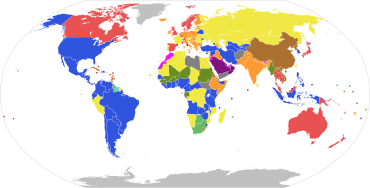
Parliamentary systems: Head of government is elected or nominated by and accountable to the legislature
Presidential system: Head of government (president) is popularly elected and independent of the legislature
Hybrid systems:
Note: this chart represents de jure systems of government, not the de facto degree of democracy.
| Part of the Politics series |
| Politics |
|---|
|
|
A semi-parliamentary system, or prime-ministerial system, is a form of government in which voters simultaneously vote for both members of legislature and the prime minister.
Like semi-presidential systems, semi-parliamentary systems are a strongly rationalized form of parliamentary systems. After Israel decided to abolish the direct election of prime ministers in 2001, there are no national prime-ministerial systems in the world; however, a prime-ministerial system is used in Israeli and Italian cities and towns to elect mayors and councils.
In a prime-ministerial system, as in standard parliamentary systems, the prime minister can still be dismissed by a vote of no confidence, this however effectively causes a snap election for both the prime minister and the legislature (a rule commonly expressed by the brocard aut simul stabunt aut simul cadent, Latin for "they will either stand together, or fall together").
Parliamentary systems originated in constitutional monarchies, in which the government was dually accountable to the parliament and the king: the plurality of opinions of elected assemblies was then balanced by the direction of the monarch. Over time, the power of hereditary monarchs came to be understood as untenable in a democracy, leading many constitutional monarchies to evolve into parliamentary republics, while in the remaining ones the monarch became an increasingly ceremonial figure: regardless of the presence of an elected or unelected head of state, the parliament was thus established as the dominating institution.
In their most basic form, parliamentary systems tend to be quite anarchic, as in the well-known cases of the French third and fourth republics.[dubious – discuss] The attitude of parliaments towards governments is essentially oppositive, as elected assemblies are often incapable of taking energetic decisions whose advantages will only be perceived in the future, but whose disadvantages are immediately experienced by the electors. This calls for a strong rationalization of parliamentary systems, such as the one that developed in the United Kingdom, where the hereditary monarch has effectively been replaced by an "elected monarch", namely the prime minister.
Being largely based on conventions, the Westminster system cannot be easily replicated in other countries.[citation needed] In his 1956 proposal, Maurice Duverger suggested that France could attain government stability by means of a direct election of the Prime Minister, that was to take place at the same time as the legislative election, by means of a separate ballot paper. The Prime Minister and his supporting parliamentary majority would need to be inseparable for the whole duration of the legislature: in case of a vote of no-confidence, forced resignation, or dissolution of the parliament, a snap election would be held for both the National Assembly and the Prime Minister.
Direct election of the prime minister, alone, would not be sufficient to ensure government stability: a second round of election should be employed so that electors can be allowed to express their ideological preferences in the first round, and designate a majority in the second. The electoral law would then provide the Prime Minister with a parliamentary majority.[dubious – discuss]
Under Charles de Gaulle, France adopted a different rationalization of parliamentary government called semi-presidential system. Duverger's proposal thus remained unnamed until the French political scientist termed it "semi-parliamentary" in 1996.
